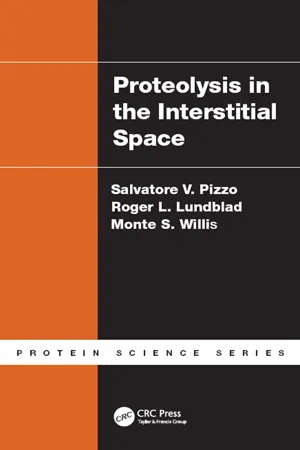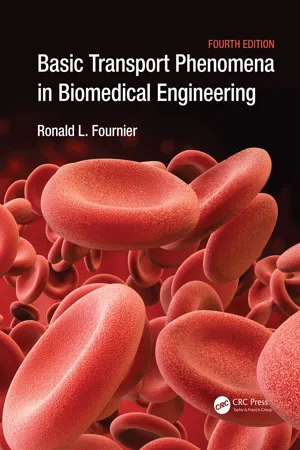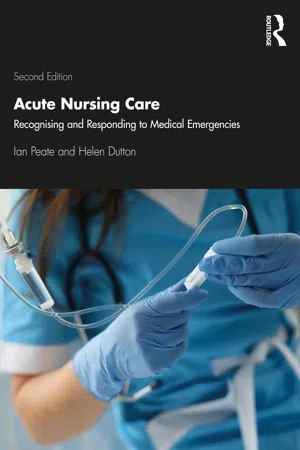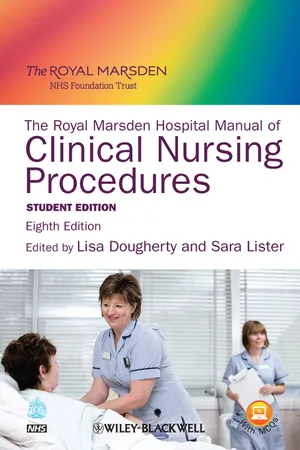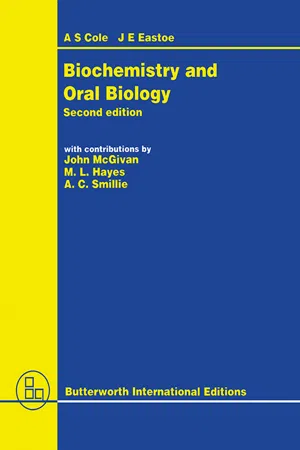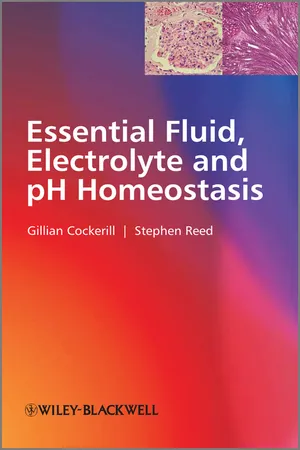Biological Sciences
Tissue Fluid
Tissue fluid, also known as interstitial fluid, is the fluid that surrounds the cells in the body. It is derived from blood plasma and contains water, nutrients, gases, and other substances that are exchanged with the cells. Tissue fluid plays a crucial role in delivering essential substances to cells and removing waste products from them.
Written by Perlego with AI-assistance
Related key terms
1 of 4
Related key terms
1 of 3
7 Key excerpts on "Tissue Fluid"
- eBook - ePub
- Salvatore V. Pizzo, Roger L. Lundblad, Monte S. Willis(Authors)
- 2016(Publication Date)
- CRC Press(Publisher)
19 But this space and its fluid content also play a role in disease. The interstitial space is a dynamic environment where an interplay of proteases, polysaccharides, cytokines, and inflammatory cells dictates the pathophysiological responses to tissue injury. In the subsequent chapters, we will consider the various compartments of this fluid, their components, and their regulation.TABLE 1.1Protein Content of Various Human Body Fluids and SecretionsFluid Protein (mg/mL)aComment Refs. Extracellular fluid N/A The body fluid can be divided into two major components: the intracellular fluid and the extracellular fluid. Between 60% and 70% of the body fluid is intracellular in nature, while the remainder is extracellular in nature. The extracellular fluid, in turn, consists of two primary components: intravascular fluid (blood plasma; approximately 25%) and extravascular fluid (approximately 75%). The extravascular fluid consists mostly of interstitial fluid with small specialized fluids in various spaces; specialized fluids include cerebrospinal fluid, synovial fluid, and ocular fluid.1 –5Blood plasma 78.9 ± 0.5bA protein-rich fluid defined by being confined within the vascular system and representing one-quarter to one-fifth of the total extracellular fluid. It is in equilibrium with the interstitial fluid, which feeds into the lymphatic system and is returned to the venous system. Other areas of extracellular fluid include the peritoneal fluid, ocular fluid, and cerebrospinal fluid. Plasma is also defined as the protein-rich fluid obtained by the removal of the cellular elements of whole blood collected with an anticoagulant. - Ronald L. Fournier(Author)
- 2017(Publication Date)
- CRC Press(Publisher)
Chapter 3 Physical properties of the body fluids and the cell membrane3.1Body fluids
To begin our study of transport phenomena in biomedical engineering, we first must examine the physical properties of the fluids that are within the human body. Many of our engineering calculations or the development and design of new procedures, devices, or treatments will either involve or affect the fluids that are within the human body. Therefore, we will focus our initial attention on the types and characteristics of the fluids that reside within the body.The body fluids can be classified into three types: extracellular, intracellular, and transcellular fluids. As shown in Table 3.1 , nearly 60% of the body weight for an average 70 kg male is comprised of these body fluids, resulting in a total fluid volume of about 40 L.Table 3.1 Body FluidsThe largest fraction of the fluid volume, about 36% of the body weight, consists of intracellular fluid, which is the fluid contained within the body’s cells, e.g., the fluid found within red blood cells, muscle cells, and liver cells. Extracellular fluid consists of the interstitial fluid that comprises about 17% of the body weight and the blood plasma that comprises around 4% of the body weight. Interstitial fluid circulates within the spaces (interstitium) between cells. The interstitial fluid space represents about one-sixth of the body volume. The interstitial fluid is formed as a filtrate from the plasma portion of the blood that is within the capillaries. The capillaries are the smallest element of the cardiovascular system and represent the site where the exchange of vital substances occurs between the blood and the tissue surrounding the capillary. We shall see that the interstitial fluid composition is very similar to that of plasma.The blood volume of a 70 kg male is 5 L, with 3 L consisting of plasma and the remaining 2 L representing the volume of the cells in the blood, primarily the red blood cells. The 2 L of cells found in the blood are filled with intracellular fluid. The fraction of the blood volume due to the red blood cells is called the hematocrit. The red blood cell volume fraction is found by centrifuging a given volume of blood in order to find the “packed” red cell volume. Since a small amount of plasma is trapped between the packed red blood cells, the true hematocrit (H) is about 96% of this measured hematocrit (Hct). The true hematocrit is about 40% for a male and about 36% for a female. The transcellular fluids- eBook - ePub
Acute Nursing Care
Recognising and Responding to Medical Emergencies
- Helen Dutton, Ian Peate, Helen Dutton, Ian Peate(Authors)
- 2020(Publication Date)
- Routledge(Publisher)
All human cells contain an aqueous fluid (intracellular fluid), known as cytosol. Apart from the organelles, this fluid contains substances such as proteins, other nutrient molecules, metabolic products and also a range of chemicals known as electrolytes. Outside the cells, there is the extracellular fluid, which is composed of the interstitial fluid and the circulating fluid; the latter consists of blood in the vascular system and the lymph in the lymphatic vessels. The extracellular fluid has a similar composition to the intracellular fluid. However, there are important differences in the composition of these fluids, particularly in the type and quantity of electrolytes and in the distribution of protein molecules, as well as the dissolved gases. The intracellular and extracellular environments are separated by the cell membrane, which is selectively permeable ; it is able to control the movement of electrolytes and other molecules across it. This characteristic will be discussed later in the chapter. The correct balance and movement of these chemicals between the intracellular and extracellular environments is vital to the maintenance of normal function and therefore health (Marieb and Hoehn 2019). A disruption of this balance is one of the factors that can cause homoeostatic imbalance and potentially lead to a medical emergency (Kumar and Clarke 2017). Electrolytes Electrolytes are charged atoms or molecules in solution which can conduct electricity. They may be cations, which have lost one electron (or more) and therefore carry a positive charge, or anions, which have gained one electron (or more) and therefore have a negative charge. An example of this is common salt, which is composed of sodium (Na) and chlorine (Cl) and is crystalline in structure. When sodium chloride is dissolved in water, the sodium and chlorine dissociate and become sodium cations (Na +) and chloride anions (note the change of nomenclature) (Cl -) - eBook - ePub
Intensive Care Nursing
A Framework for Practice
- Philip Woodrow(Author)
- 2018(Publication Date)
- Routledge(Publisher)
fluid, with potential “third spaces” that normally contain no or insignificant volumes of fluid (e.g. 10–20 ml pericardial fluid), but which with disease can contain significantly more. Extracellular fluid is divided between:- intravascular
- interstitial
compartments. In health, water distribution is approximately as shown in Figure 33.1 :Perfusion
Tissue perfusion is needed to supply nutrients to cells and remove waste products of metabolism. Tissue perfusion relies on pressure gradients across capillary walls. These gradients are the sum of:- resistance in tissues;
- (mean) arterial blood pressure (MAP);
- colloid osmotic pressure.
■ Figure 33.1 Normal distribution of body waterIn health, each day nearly five times total blood volume moves in and out of the cardiovascular system (Barrett et al ., 2016). Movement is largely regulated by pressures. Osmotic pressure exerted within the bloodstream is called colloid osmotic pressure (COP ). Colloid osmotic pressure is normally mainly created by plasma proteins, especially albumin. Capillaries are semipermeable: thin, sqauemous (= scale-like) epithelium, with gaps between cells. At the arteriolar end, intracapillary pressure (average: 30 mmHg (Hall, 2016)) exceeds combined interstitial and COP, forcing fluid into tissues. In health, homeostasis maintains normal fluid balance. With ill health, gross and problematic fluid imbalance can occur.Starling’s (1896) research established the effects of osmotic and hydrostatic pressures on fluid movement, forming the basis for twentieth-century approaches to fluid management. These beliefs included that colloid osmotic pressure drew extravascular back near venule ends of capillaries. It is now known that most fluid returns to the cardiovascular system via lymphatics (Delaney, 2016). Otherwise, Starling’s findings remain largely true for the healthy body, but failure of resuscitation fluids to behave as predicted raised suspicions that other factors also influenced fluid distribution. One factor is clearly the inflammatory response, contributing to capillary leak. But more recently glycocalyx has been increasingly studied. Glycocalyx is a polysaccharide (“sugary slime”) that coats many cells to protect them and enable them to function. Many bacterial cell membranes contain glycocalyx. Vascular glycocalyx contributes to homeostatic and defensive cardiovascular functions, including capillary blood flow (Reitsma et al ., 2007) and permeability to water and electrolytes (Becker et al - Lisa Dougherty, Sara Lister, Lisa Dougherty(Authors)
- 2011(Publication Date)
- Wiley-Blackwell(Publisher)
In the human homoeostatic state, the intake of fluids equals fluid excreted from the body, thereby maintaining optimal hydration. In nursing practice, this term refers to the procedure of measuring fluid input and output to determine fluid balance (Marieb and Hoehn 2010, Scales and Pilsworth 2008).Anatomy and physiology Body compositionThe human body is made up of approximately 60% water (this varies with age, gender and percentage of fatty tissue) (Alexander et al . 2000, Scales and Pilsworth, 2008, Urden et al. 2002). Bodily water/fluid is essential to life and vital for:controlling body temperaturethe delivery of nutrients and gases to cellsthe removal of wasteacid–base balance andthe maintenance of cellular shape (Baumberger-Henry 2008).Total body water is distributed between two main compartments: intracellular fluid (ICF, within the cell) and extracelluar fluid(ECF, outside the cell). ECF is further divided into the intravascular space, within the blood vessels (known as plasma), the interstitial space which surrounds the cells and the transcellular space. The transcellular space contains specialized fluids such as cerebrospinal fluid but does not readily exchange fluid with other compartments so is rarely considered in fluid management (Bishop 2008, Haskal 2007).Bodily fluid is a composition of water and a variety of dissolved solutes which Marieb and Hoehn (2010) classify as electrolytes and non-electrolytes. Non-electrolytes include glucose, lipids, creatine and urea and are molecules that do not dissociate in solution and have no electrical charge. Electrolytes such as potassium, sodium, chloride, magnesium and bicarbonate all dissociate in solution into charged ions that conduct electricity. Concentration of these solutes varies depending on the compartment in which they are contained; for example, ECF has a high sodium content (135–145 mmol/L) and, relatively low in potassium (3.5–4.5 mmol/L) and ICF is the reverse – high in potassium but lower in sodium. The movement and distribution of fluid and solutes between compartments are controlled by the semi-permeable phospholipid cellular membranes that separate them (Baumberger-Henry 2008).- eBook - ePub
- A. S. Cole, J. E. Eastoe(Authors)
- 2014(Publication Date)
- Butterworth-Heinemann(Publisher)
Section 6 Soft tissuesOutlineChapter 25: The body fluids Chapter 26: Epithelium Chapter 27: Connective tissuePassage contains an image
Chapter 25The body fluids
Publisher Summary
This chapter focuses on body fluids. The human body is regarded as a colloidal solution of great complexity as there is a continuous aqueous phase throughout. The obvious differences in composition that occur from one region to another are maintained by physiological barriers that take the form of membranes and intercellular macromolecules. Except in the case of oxygen, entry of material into the body occurs by absorption across the intestinal epithelium, which is subjected to a constantly changing chemical environment. Apart from the great variety of natural food constituents, it may also be exposed to a tremendous range of synthetic compounds devised by food scientists and pharmaceutical chemists. The life of an intestinal epithelial cell is extremely short, and the whole of the intestinal lining is replaced in rather less than 2 days. Although energy-requiring transport mechanisms ensure that valuable materials such as sugars and amino acids are actively absorbed into the bloodstream, useless and even harmful substances may pass across the intestinal barrier if their physicochemical characteristics are such to allow them to traverse it by passive means. Once water and other materials have been absorbed, they are distributed among the various fluid compartments.The human body may in a sense be regarded as a colloidal solution of great complexity since there is a continuous aqueous phase throughout. The obvious differences in composition which occur from one region to another are maintained by physiological barriers which take the form of membranes and intercellular macromolecules.Except in the case of oxygen, entry of material into the body occurs by absorption across the intestinal epithelium which is subjected to a constantly changing chemical environment. Apart from the great variety of natural food constituents it may also be exposed to a tremendous range of synthetic compounds devised by food scientists and pharmaceutical chemists. It is not surprising, therefore, to find that the life of an intestinal epithelial cell is extremely short and that the whole of the intestinal lining is replaced in rather less than 2 days. - eBook - ePub
- Gillian Cockerill, Stephen Reed(Authors)
- 2011(Publication Date)
- Wiley(Publisher)
Part 2 Fluid and electrolyte homeostasis OverviewPart 2 of this text builds upon some of the fundamental physiochemical principles developed in Part 1 to explain normal and abnormal electrolyte homeostasis. Where appropriate, some re-statement of key points from Part 1 is made. Important aspects covered include the roles of the kidney in fluid balance, normal functions of selected minerals and their physiological regulation. Examples of the laboratory methods used for the quantification of electrolytes and interpretation of the results of such tests and some of their limitations are described and explained with reference to example data and case studies.Passage contains an image Normal physiology
Passage contains an image SECTION 2.i Fluid translocation: plasma to ISF and ISF to ICF
The human body is composed predominantly of ‘compartmentalised water’ containing a wide variety of solutes. Water within cells provides an appropriate environment to support the biochemical reactions, whilst water within the extracellular compartment essentially facilitates transport of nutrients to and waste products away from tissue cells. The solutes within body fluids create osmotic forces acting upon cell membranes. In order to avoid cells swelling or shrinking, those osmotic forces (which are of course functions of solute concentrations) exerting pressure on both sides of cell membranes must be balanced, whilst at the same time allowing the passage of solutes into and out of tissue cells. Maintenance of such a dynamic situation requires careful control if failure and consequent ill-health are to be avoided.Nutrients enter the body via the gastrointestinal system and the lungs, and pass into the bloodstream for distribution to tissues for immediate use or to sites of storage. A normal blood pressure is required to ensure normal function of tissues and organs. Although there is a general appreciation that high blood pressure (hypertension) is a risk factor for a number of diseases of, for example, the vasculature and kidneys, a low blood pressure (hypotension) is also undesirable as this will result in poor tissue perfusion and therefore poor nutrient delivery to cells.
Index pages curate the most relevant extracts from our library of academic textbooks. They’ve been created using an in-house natural language model (NLM), each adding context and meaning to key research topics.
Explore more topic indexes
Explore more topic indexes
1 of 6
Explore more topic indexes
1 of 4
